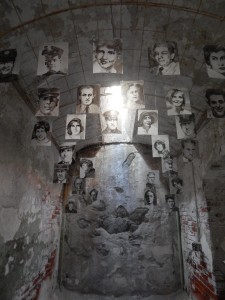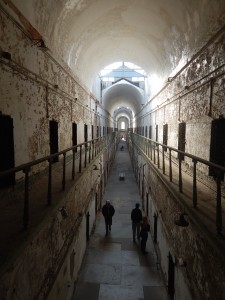This afternoon, I visited Eastern State Penitentiary as a part of my Praxis Independent Study “Art and Incarceration”. The purpose of my visit was to look at the art exhibits installed there, which are one way in which Eastern State seeks to promote dialogue and reflection about incarceration today. However, I kept coming back, throughout my wanderings up and down the various corridors, to thoughts about Eastern State’s role in telling and silencing historical narratives. One of the art exhibits, by Cindy Stockton Moore, featured fifty portraits of people who were murdered by people once incarcerated in Eastern State Penitentiary. The aim of this exhibit, according to Moore’s description, was to “create a more complete picture of the men and women imprisoned here, and the consequences of their actions,” since the victims of crimes aren’t often discussed in tours or exhibits today.
After leaving the exhibit, my friend who I went with said that, until seeing that exhibit, she hadn’t realized that she’d been putting herself in the place of the prisoners during our entire visit, that she’d been imagining what it was like to be incarcerated at Eastern State instead of imagining what it was like to be harmed by someone who was incarcerated there. I said that I agreed, that I too had been focusing solely on the horrors of solitary confinement and a loss of freedom experienced by prisoners both past and present, but that I thought that forcing visitors to imagine the experiences of incarcerated people without a focus on harms they may have committed was valuable. We live in a victim-centered society, in which the rights of victims- to compensation, to revenge- are often prioritized over the rights of prisoners, and are used to justify increasingly harsh punishments and restrictions on freedom. In Pennsylvania, rhetoric about victims’ rights has been used to pass both the Revictimization Relief Act- which was declared unconstitutional for its restrictions on free speech- and House Bill 1089, which forces prisoners to pay restitution to the victims of crimes they committed. I think that both people who commit harms and people who experience those harms deserve to have their stories heard, to be understood complexly and in the context of larger social structures. But since we live in a society that privileges one of those experiences while demonizing the other, I think it’s valuable for an historical site to put aside the often-heard narratives in favor of amplifying the ones too often ignored.
All of which brings me back to our reading for this week, mainly Michel-Rolph Trouillot’s discussion of power and silence in the production of history. Trouillot discusses how historical narratives are produced in a way that amplifies some stories and versions of history while silencing others, and through his examples- such as the story of Jean-Baptiste Sans Souci- attempts to bring voice to the silences of history and show the operation of power in the construction of narratives. I could see how Moore might claim that, through her art exhibit at Eastern State, she is doing that same work, bringing voice to murder victims whose stories aren’t told, while the experiences of the people who killed them are immortalized in Eastern State’s state of stabilized ruin. However, if Moore, or anyone, were to make that claim, based on Trouillot’s analysis of power I would disagree, because in a broader context of how prisoners’ and crime victims’ narratives are told, victims are not the ones silenced. All of this leads me to wonder if silencing the past- in specific parts, and in specific contexts- can play an important role in uncovering other, more pervasive, silences. If one silences an often heard narrative to amplify a faint echo of an often-forgotten other, I don’t think that silence is really a silence at all.


